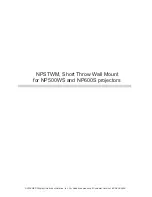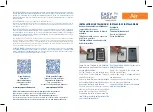
Refrigeration Service Procedures
125
Vacuum Pumps
When evacuating, a two stage, five to seven CFM
pump is recommended. It is also recommended
that dry nitrogen be used first. Ideally, a new
vacuum pump should be used and dedicated for
use with R404A systems because residual
refrigerants may remain in used vacuum pumps.
Pumps used with other Thermo King refrigerants
may be used but extreme care should be taken to
prevent contamination of R404A systems with
other refrigerants.
The Thermo King Evacuation Station is
recommended. This station is available from
service parts (see Tool Catalog). See Truck and
Trailer Service Bulletin T&T 061 for additional
details.
Use only recommended vacuum pump oils and
change oil after every major evacuation. Vacuum
pump oils are highly refined and the use of
contaminated oils will prevent the desired vacuum
from being obtained. Failure to follow these
recommendations may result in conditions that
will destroy the vacuum pump.
Gauge Manifold Sets
Gauge manifold sets that show the correct
pressure-temperature relationship should be used.
Gauge manifolds and manifold hoses used with
other Thermo King refrigerants maybe used but
extreme care should be taken to prevent
contamination of the R404A systems with other
refrigerants. Purge manifold and hoses with dry
nitrogen before using.
Never use equipment that
may be contaminated with automotive type
Polyalkylene Glycol (PAG) oils.
Refrigerant Recovery
Systems used for the recovery of R404A should
be dedicated to the recovery of this refrigerant.
Consult the manufacturer of your recovery
equipment for details.
Accumulator Replacement
Removal
1. Pump down the low side and equalize the
pressure to slightly positive. Make sure to
front seat the suction service valve to isolate
the low side and use the suction access port to
access the low side.
2. Unsolder the inlet and outlet refrigerant
suction lines from the accumulator tank.
3. Unbolt and remove the accumulator from the
unit.
Installation
1. Place the accumulator in the unit and tighten
the mounting bolts.
2. Solder the inlet and outlet suction lines to the
accumulator tank.
3. Pressurize the low side and check for leaks.
4. If no leaks are found, replace the liquid line
drier then evacuate the low side.
5. Open the refrigeration valves and place the
unit in operation. Check the refrigerant charge
and the compressor oil. Add as required.
Compressor Test
NOTE: The Scroll compressor can not be
pumped down below 10 in. Hg vacuum
(-34 kPa). Check the compressor efficiency
using the following procedure.
1. Install a gauge manifold set. Attach the low
pressure gauge to the service port on the
suction service valve. Attach the high pressure
gauge to the discharge service port. A low loss
fitting must be used on the hose connected to
the discharge service port.
2. Run the unit in high speed cool until the
system pressures stabilize.
3. Note the discharge pressure on the high
pressure gauge.
4. Cover the condenser and check the discharge
pressure. The compressor should be able to
increase the discharge pressure by at least 100
psig (689 kPa) or to 375 psig (2586 kPa). The
Summary of Contents for UT-1200
Page 10: ...Table of Contents 10...
Page 20: ...Safety Precautions 20...
Page 76: ...Operating Instructions for Premium HMI Control Panel 76...
Page 88: ...Electrical Maintenance 88...
Page 98: ...Engine Maintenance 98 Figure 167 Fuel Components...
Page 142: ...Refrigeration Service Procedures 142...
Page 148: ...Clutch Maintenance 148...
Page 150: ...Structural Maintenance 150...
Page 162: ...Wiring and Schematic Diagrams Index 162...
Page 163: ...163 Schematic Diagram Page 1 of 2...
Page 164: ...164 Schematic Diagram Page 2 of 2...
Page 165: ...165 Wiring Diagram Page 1 of 5...
Page 166: ...166 Wiring Diagram Page 2 of 5...
Page 167: ...167 Wiring Diagram Page 3 of 5...
Page 168: ...168 Wiring Diagram Page 4 of 5...
Page 169: ...169 Wiring Diagram Page 5 of 5...
















































